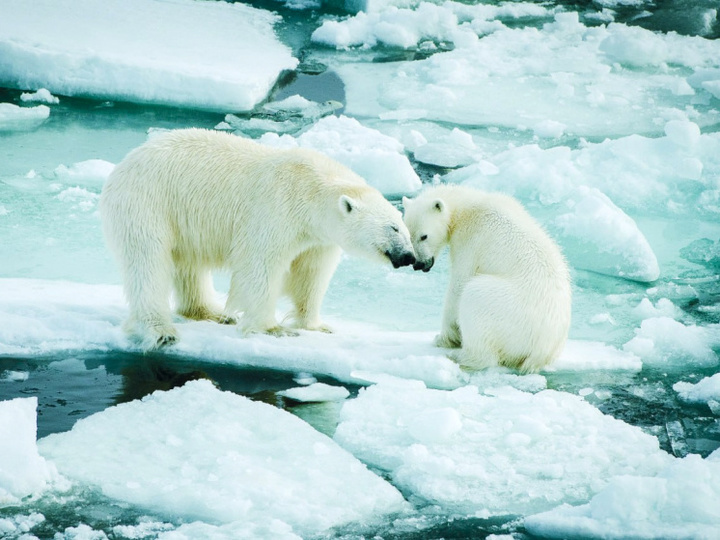Exploring the Arctic: scientists will conduct an aerial survey of polar bears for the first time
[ad_1]
Russian scientists will closely study the population of polar bears living in the Kara Sea region. Previously, information about their number was only approximate, but now the animals will be counted using modern equipment and their migration routes will be determined. Representatives of the oil company, the Ministry of Natural Resources of the Russian Federation and the Institute of Ecology and Evolution named after. Severtsova.
In the near future, four major studies will be launched in the Russian Arctic, which will help to learn more about the animals living there, the state of the environment, and also outline environmental measures. For 2024–2027, the oil company plans to study the populations of polar bear and wild reindeer in the north of the Krasnoyarsk Territory, compile maps of the ecological sensitivity of the shores of the Yenisei Bay and the adjacent waters of the Kara Sea, as well as assess the habitat conditions of valuable fish species at the mouth of the Yenisei.
For the first time, scientists will conduct an aerial survey of polar bears to assess the state of the Kara subpopulation – the scientific world does not currently have this data.
“The Kara polar bear population has been identified since 2020. Before this, the Kara-Barents Sea population was recognized in Russia. Therefore, clarifying information on it is especially important. Little was known about it, except for isolated information and approximate calculations, and no serious research was carried out,” said Olga Krever, Deputy Director of the Federal State Budgetary Institution “Roszapovedtsentr” of the Russian Ministry of Natural Resources.
The “census” of animals will be carried out using the most modern equipment: two laboratory aircraft equipped with new generation thermal imagers will fly over simultaneously, and AI software will help process aerial photography in the visible and infrared spectrum. Scientists will also test a prototype of the latest satellite transmitter designed to track the movements of bears, their activity and seasonal migration.

“Before this, we always attached satellite tags in the form of collars, but they only held well on females, because males have wider necks and the sensors simply fell off. Therefore, we are planning to produce an innovative method of tagging males with a new prototype tag that is attached to the animal’s ear. The polar bear again and again becomes the object of attention of scientists. Not so much because it is big, but because of its significance and importance to the ecosystem. It can serve as an indicator of change. There are 4 populations of polar bears in the Russian Arctic, two of them are well studied, while the Kara and Laptev ones are less so,” commented Alexander Pashali, director of the department of scientific and technical development and innovation of Rosneft PJSC.
Director of the Institute of Ecology and Evolution named after A.N. Severtsov RAS Sergei Naidenko said that since 2020, the institute and Rosneft, within the framework of the national project “Ecology,” have been implementing a program to study key species-bioindicators of the stable state of Arctic ecosystems: the polar bear, Atlantic walrus and ivory gull listed in the Red Book of Russia, as well as wild reindeer. The results of work within the program helped to update and significantly expand the array of data on the state of populations, migration routes and genetic diversity of the indicator species under study.
“We conducted three large expeditions to study the polar bear. We visited Cape Zhelany and Alexander Land in the Arctic. We captured 19 individuals and tagged 5 females, and collected information on biological samples. This gave us the opportunity to get movement tracks, we found out a lot of interesting things. For example, that females, as soon as they leave the den with newborn cubs, immediately try to move to the ice, and then travel long distances,” Naidenko shared.

According to Pashali, it is also planned to study the Taimyr-Evenki reindeer population.
“We have already completed some tasks to study it at the last stage: we conducted two extensive expeditions, the observation area was more than 26 thousand kilometers. Based on the collected data, mathematical models of population dynamics were built, and its actual and maximum numbers were established, taking into account food resources. In a future step, we will form a complete picture of the state of the population, and also put forward a hypothesis why deer migration has changed so much in the last few years. Wild reindeer is an important part of the way of life of the indigenous population of Taimyr,” the speaker emphasized.
In addition, by 2026, scientists plan to collect data to build maps of the ecological sensitivity of the shores of the Yenisei Bay and the adjacent waters of the Kara Sea, in the area of Sever Bay, as well as the Brekhovsky Islands reserve. This will make it possible to develop measures to protect the most important habitats of the Red Book and valuable bird species: the white-billed loon, the white-tailed eagle, the peregrine falcon, the little swan, the red-breasted goose and the lesser white-fronted lesser white-fronted lesser white-fronted lesser white-fronted lesser white-fronted lesser white-fronted geese.
During the flights, an innovative laboratory aircraft with special equipment will be used: automated photo and video equipment and a high-precision GPS complex.
The total duration of the route will be more than 1200 km. The work will require researchers to have a high level of coordination in collecting and processing data: to build maps, it will be necessary to process navigation data and build aerial survey routes, decipher images and audio recordings, describe the distribution of animals and recorded features of ecosystems along the flight route, and then supplement the information with stock and literary sources data. In addition, in the Brekhov Islands National Nature Reserve, observations will be carried out along boat routes during the nesting period.
At the mouth of the Yenisei, researchers will check the habitat conditions and status of populations of Red Book and valuable fish species: sterlet, Siberian sturgeon, Siberian taimen, muksun, nelma, Arctic omul and whitefish.
After this, recommendations for their protection and conservation will be developed.
The data obtained through genetic analysis will help replenish the Russian national collection of reference genetic materials. The work will involve various equipment: boats, river-sea class vessels, as well as a hovercraft. The total length of the study area, including tributaries of the Yenisei, will be about 280 km.
Photo: Department of Information and Advertising of PJSC NK Rosneft
[ad_2]
Source link








